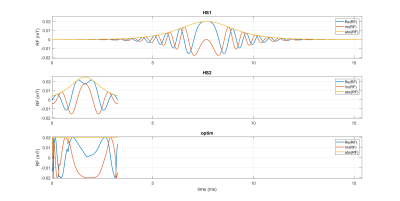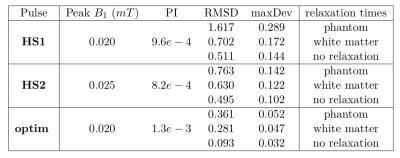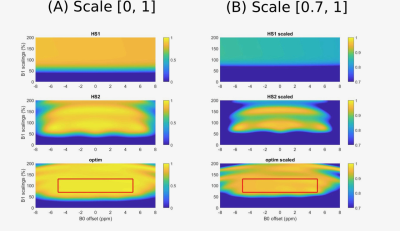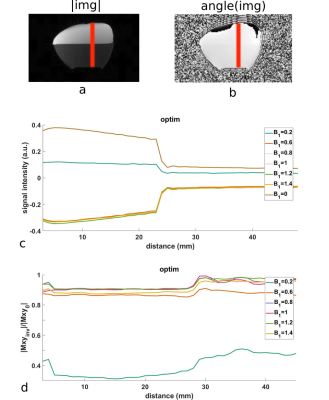3952
Time optimal control based design of robust inversion pulses1Graz University of Technology, Institute of Medical Engineering, Graz, Austria, 2Institute of Mathematics and Scientific Computing, University of Graz, Graz, Austria, 3Physikalisch-Technische Bundesanstalt (PTB), Braunschweig and Berlin, Berlin, Germany
Synopsis
The aim of this work is to design short and B0- and B1-robust inversion pulses by optimal control. A time-optimal control framework is used that incorporates variations within B0- and B1-fields. The optimized RF pulse is compared numerically to two hyperbolic-secant pulses and shows a very good efficiency over a broad set of B0-offsets and B1-scalings. Two phantom measurements are performed on a 3T MRI system for various scalings of B1 that verify the results, one with a cylindrical MRI phantom, the other one with oil and water with a contrast agent, demonstrating also the B0-robustness of the proposed pulse.
Introduction
Composite1 and adiabatic2 pulses fulfill the requirement of $$$B_{1}$$$-robustness, however, at the cost of a higher pulse energy3. Therefore, there is still demand4,5 for $$$B_{0}$$$- and $$$B_{1}$$$-robust inversion pulses with a high inversion efficiency. Furthermore, variations within the $$$B_{0}$$$-field can affect the flip angle substantially6. RF pulse optimization by means of optimal control yields excellent efficiency results while addressing RF energy, hardware constraints and minimizing the pulse duration7,8. Moreover, optimal control techniques were used for the design of $$$B_{0}$$$- and $$$B_{1}$$$-robust RF pulses9,10,11. In a preceding work12, $$$B_{1}$$$-robust, slice-selective inversion pulses with a fixed pulse duration were optimized. Below, the work is extended to time optimal control i.e. minimizing the pulse duration, and to $$$B_{0}$$$- and $$$B_{1}$$$-robust design of non-selective inversion pulses. The optimized results are investigated numerically and validated by phantom measurements on a 3T MRI system.Theory
The optimization problem is given as\begin{align*} &\min J = T + \frac{\alpha}{2}\int \limits_{0}^{T} \left(B_{1}(t)\right)^{2} dt, \\ &\text{s.t.} \: \begin{cases} \left|M_{i,j}(T)-M_{d}\right| < \varepsilon \quad \forall \:i=1, \cdots N,\: j=1, \cdots K, \\ 0\leq B_{1} \leq B_{1,\mathrm{max}}. \end{cases}\end{align*}
Therein, $$$M_{d}=(0,0,-1)^\top$$$ defines the desired state for non-selective inversion and $$$\varepsilon$$$ is allowed absolute error for the inversion efficiency. $$$M_{i,j}(T)$$$ is the solution of the Bloch equations at the terminal time $$$T$$$ for different $$$B_{0}$$$-offsets $$$i=1, \cdots N$$$ and $$$B_{1}$$$-scalings $$$j=1, \cdots K$$$. The last inequality describes the box constraints which limits the maximal RF amplitude with $$$B_{1,\mathrm{max}}$$$. Furthermore, the latter term in the cost functional reduces the power integral with parameter $$$\alpha >0$$$. The full Bloch equations with relaxation effects are solved with symmetric operator splitting13. The optimization is based on a trust-region, semi-smooth quasi-Newton method7,14 and the derivatives are supplied using adjoint calculus.
Methods
The proposed optimization method designs pulses independent of a sophisticated initial guess due to globalization by a trust-region framework14. This is demonstrated by choosing a $$$10ms$$$ RF pulse with random magnitude and phase values as an initial. Additionally, for numerical comparison, two adiabatic, hyperbolic-secant RF pulses were designed. The first was a commonly implemented pulse with duration of $$$15.36ms$$$ and bandwith of $$$\Delta f = 10.54kHz$$$ $$$(\textbf{HS1})$$$15, the second was designed with identical pulse duration ($$$3.28ms$$$) and bandwidth ($$$2.35kHz$$$) as the optimized RF pulse $$$(\textbf{HS2})$$$. The relaxation times were chosen to coincide with the cylindrical phantom used in the experimental validation, $$$T_{1}=102ms$$$ and $$$T_{2}=81ms$$$. We optimized $$$B_{0}$$$-robustness for an offset of $$$\pm 5ppm$$$ at $$$3T$$$ in $$$N=11$$$ steps and simultaneously $$$B_{1}$$$-robustness for $$$70\%$$$ to $$$130\%$$$ in $$$K=9$$$ steps. The numerical evaluation of the optimization was done by means of root-mean-square deviation (RMSD) and maximum deviation (maxDev) for each scaling of $$$B_{1}$$$ and each offset of $$$B_{0}$$$. The optimized RF pulse was implemented on a 3T MRI system (Magnetom Vida, Siemens Healthcare, Erlangen, Germany) as a preparation pulse with $$$TI=6.36ms$$$ in a FLASH sequence ($$$FOV = 300mm, \text{matrix} = 512 \times 256$$$) and validated in two phantom experiments. First, the cylindrical MR phantom was used ($$$TE/TR = 3.3/700ms$$$). Second, a water bottle consisting of $$$400ml$$$ oil and $$$400ml$$$ water with $$$0.2 ml$$$ gadoteric acid resulting in $$$T_{1} = 400ms$$$ was used ($$$TE/TR = 4.9/1500 ms$$$). Additionally, for the cylindrical phantom, we performed a double-angle-measurement16 for analyzing variations within the $$$B_{1}$$$-field.Results and Discussion
Figure 1 depicts all RF pulses, whereby the pulse duration of $$$\textbf{optim}$$$ was reduced from initially $$$10ms$$$ to $$$3.28ms$$$. The optimized RF exhibits a larger power integral, Table 2, since the RF magnitude is on its box constraint introduced during optimization nearly everywhere, Figure 1. On the other hand, $$$\textbf{optim}$$$ exhibits a heavily increased inversion efficiency with reduction in RMSD and maxDev by a factor of two to three compared with $$$\textbf{HS2}$$$ and five to six compared with $$$\textbf{HS1}$$$ for phantom relaxation times. All pulses show increased inversion efficiency for white matter and without relaxation both in RMSD and maxDev, Table 2. This was expected as relaxation is known to influence simulation results13. Figure 3 depicts the inversion efficiency for all RF pulses over a broader set of $$$B_{0}$$$- and $$$B_{1}$$$-variations. The optimized RF pulse (bottom line) performs well within the optimized range of $$$B_{0}$$$- and $$$B_{1}$$$-values (red box). $$$\textbf{HS1}$$$ (top line) shows an evenly distributed inversion performance when reaching the $$$B_{1}$$$-threshold around $$$75 \%$$$ of $$$B_{1}$$$. This coincides with the large bandwidth of it, however, the efficiency itself is not as good as with the others. The optimized pulse $$$\textbf{optim}$$$ was validated in phantom measurements, Figure 4. For a $$$B_{1}$$$-scale of $$$80\%$$$ to $$$120 \%$$$, the pulse inverts magnetization with efficiency of more than $$$90\%$$$ (see part e). Figure 5 shows the same experiment with the water bottle containing oil and water. Again, for a scale of $$$80\%$$$ to $$$120 \%$$$, the inversion efficiency is more than $$$90\%$$$ (part e). Hence, the inversion efficiency is good for oil as well with a frequency offset of $$$3.4ppm$$$, underlining the $$$B_{0}$$$-robustness of the presented RF pulse.Conclusion
Non-selective and time-optimal inversion pulses were designed by robust optimal control over a defined set of $$$B_{0}$$$- and $$$B_{1}$$$-variations. The inversion efficiency and robustness were validated in extensive phantom measurements. A consequent future development will be the simultaneous control of the gradient for slice-selective pulses.Acknowledgements
No acknowledgement found.References
1Composite RF Pulses for B1+-insensitive volume excitation at 7 Tesla. Moore J, Jankiewicz M, Zeng H, Anderson A.W, Gore J.C. J Magn Reson 2010;205:50--62.
2Handbook of MRI Pulse Sequences. Bernstein M.A, King K.F, Zhou X.J. Elsevier Academic Press, 2004.
3Symmetric pulses to introduce arbitrary flip angles with compensation for RF inhomogeneity and resonance offsets. Garwood M, Ke Y. J Magn Reson 1991;94:511-525.
4Recommended Implementation of Arterial Spin-Labeled Perfusion MRI for Clinical Applications: A Consensus of the ISMRM Perfusion Study Group and the European Consortium for ASL in Dementia. Alsop D.C, Detre J.A, Golay X, Günther M, Hendrikse J, Hernandez-Garcia L, Lu H, MacIntosh B.J, Parkes L.M, Smits M, van Osch M.J.P, Wang D.J.J, Wong E.C, Zaharchuk G. Magn Reson Med 2014;00:00-00.
5Optimization of adiabatic pulses for Pulsed ASL at 7T - Comparison with Pseudo-continuous ASL. Wang K, Shao X, Yan L, Jin J, Wang D. In Proceedings of the International Society of Magnetic Resonance in Medicine (ISMRM), 2020.
6Factors influencing flip angle mapping in MRI: Pulse shape, slice-select gradients, off-resonance excitation, and B0 inhomogeneities. Wang J, Mao W, Quin M, Smith M.B, Todd Constable R. Magn Reson Med 2006;56:463-468.
7Magnetic resonance RF pulse design by optimal control with physical constraints. Rund A, Aigner C.S, Kunisch K, Stollberger R. IEEE Trans Med Imaging 2018;37:461-472.
8Simultaneous multislice refocusing via time optimal control. Rund A, Aigner C.S, Kunisch K, Stollberger R. Magn Reson Med 2018;80:1416-1428.
9Exploring the limits of broadband excitation and inversion pulses. Kobzar K, Skinner T.E, Khaneja N, Glaser S.J, Luy B. J Magn Reson 2004;170:236-243.
10Optimal control design of preparation pulses for contrast optimization in MRI. Van Reeth E, Ratiney H, Tesch M, Grenier D, Beuf O, Glaser S.J, Sugny D. J Magn Reson 2017;279:39-50.
11BEEEP: B1-robust energy efficient excitation pulses. Van Reeth E, Ratiney H, Beuf O, Kanice S, Glaser S.J, Sugny D. In Proceedings of the International Society of Magnetic Resonance in Medicine (ISMRM), 2019.
12Inversion pulses with B1-robustness and reduced energy by optimal control. Graf C, Aigner C.S, Rund A, Lesch A.J, Stollberger R. In Proceedings of the International Society of Magnetic Resonance in Medicine (ISMRM), 2020.
13Simulation of Bloch and Bloch-McConnell equations - speed and accuracy. Graf C, Rund A, Aigner C.S, Kunisch K, Stollberger R. In Proceedings of the International Society of Magnetic Resonance in Medicine (ISMRM), 2019.
14A hybrid semismooth quasi-Newton method for nonsmooth optimal control with PDEs. Mannel F, Rund A. Optim Eng (2020).
15 Comparison of 2D and 3D single-shot ASL perfusion fMRI sequences. Vidorreta M, Wang Z, Rodriguez I, Pastor M.A, Detre J.A, Fernandez-Seara M.A. Neuroimage 2013;0:662-671.
16Imaging of the Active B1 Field in Vivo. Stollberger R, Wach P. Magn Reson Med 1996;35:246-251.
Figures




